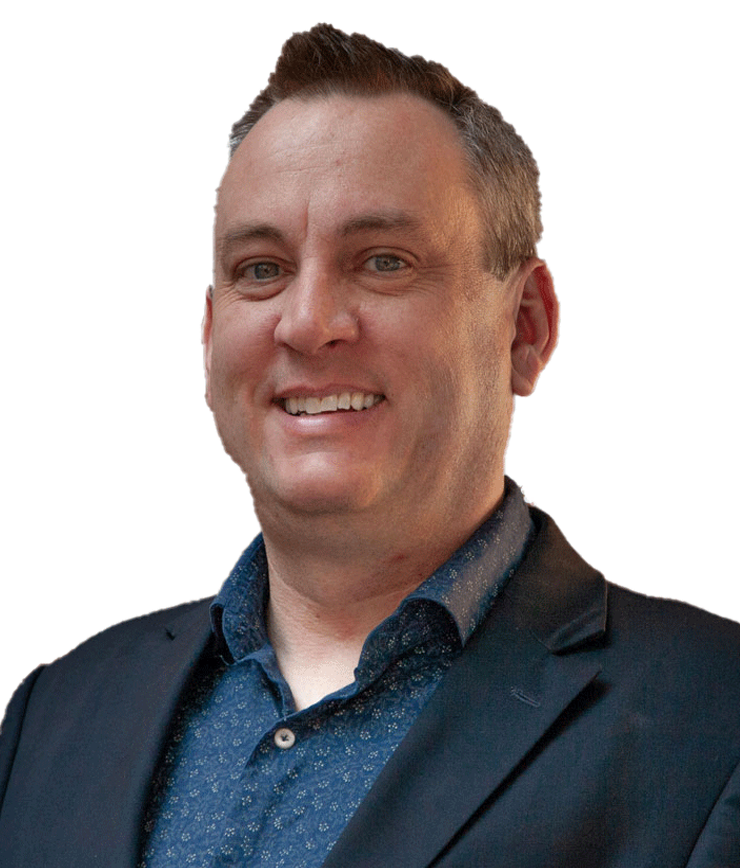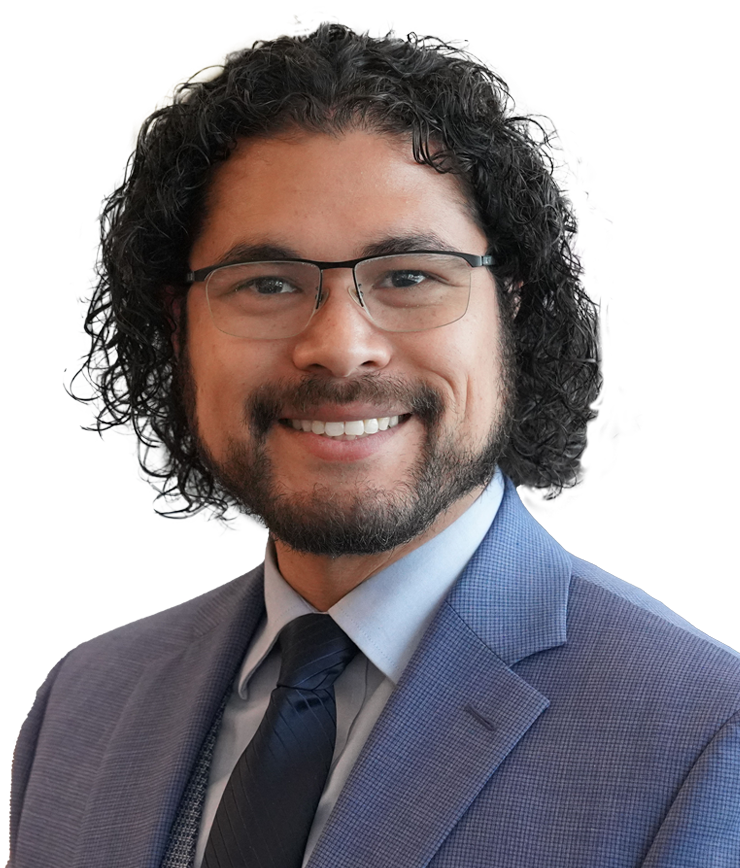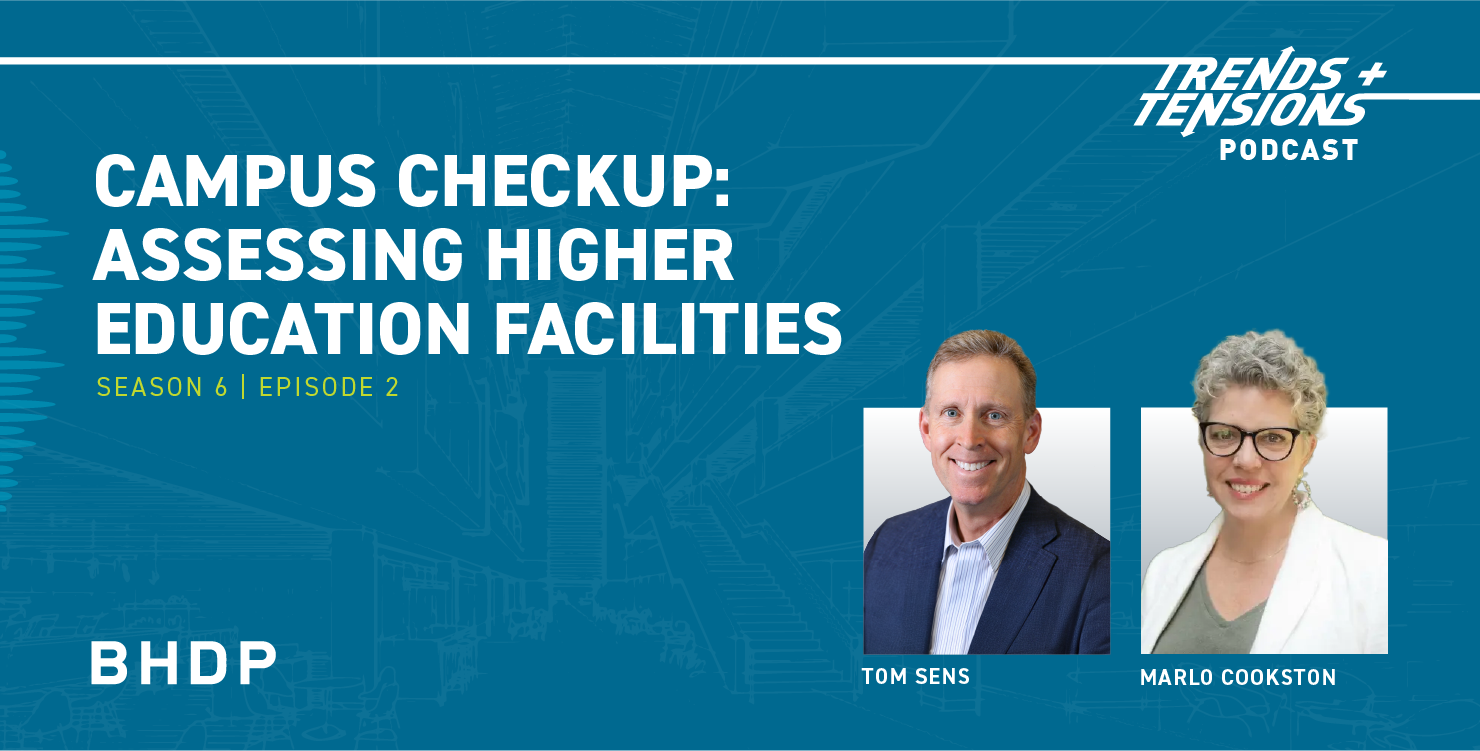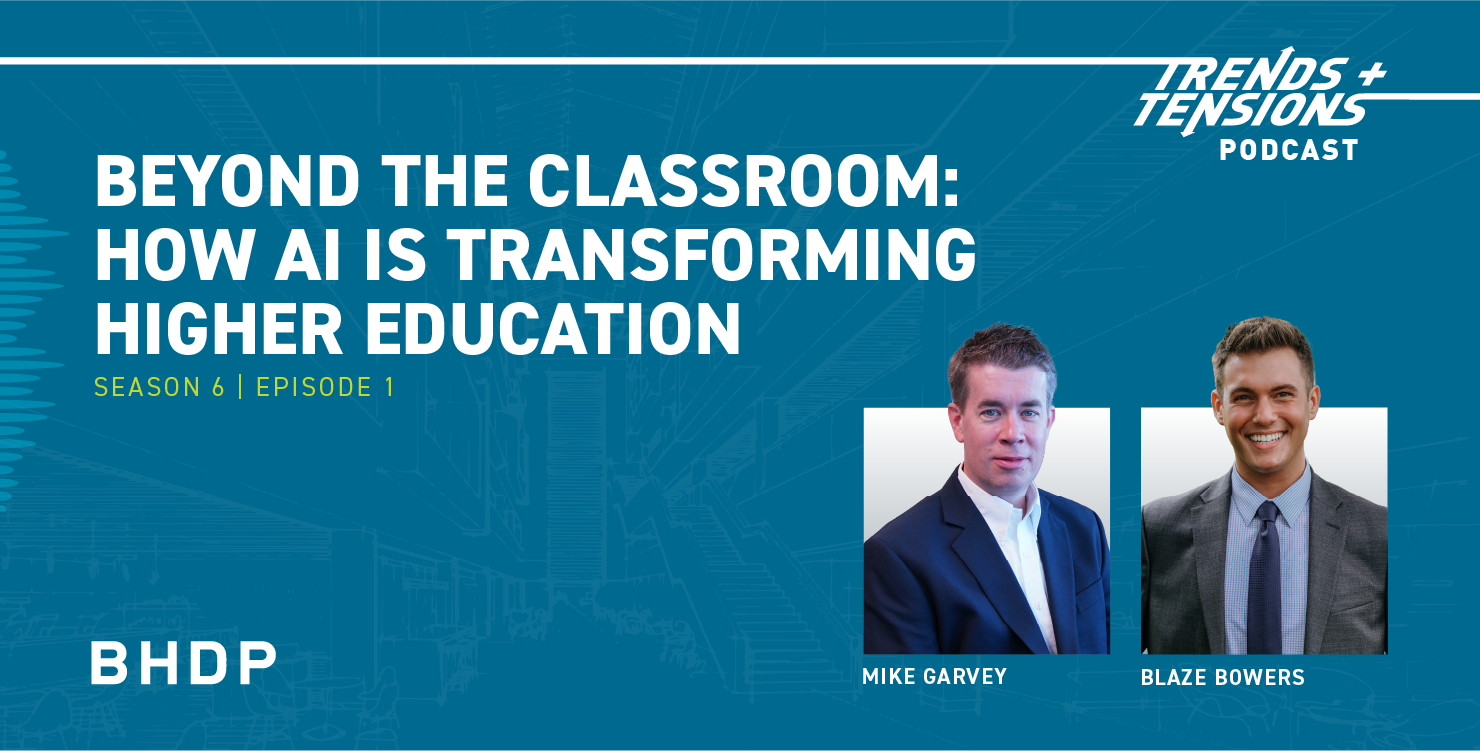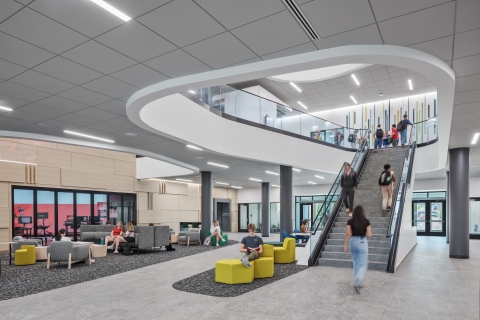
Next-Gen Students, Next-Gen Campuses: Generation Alpha’s Influence on Design
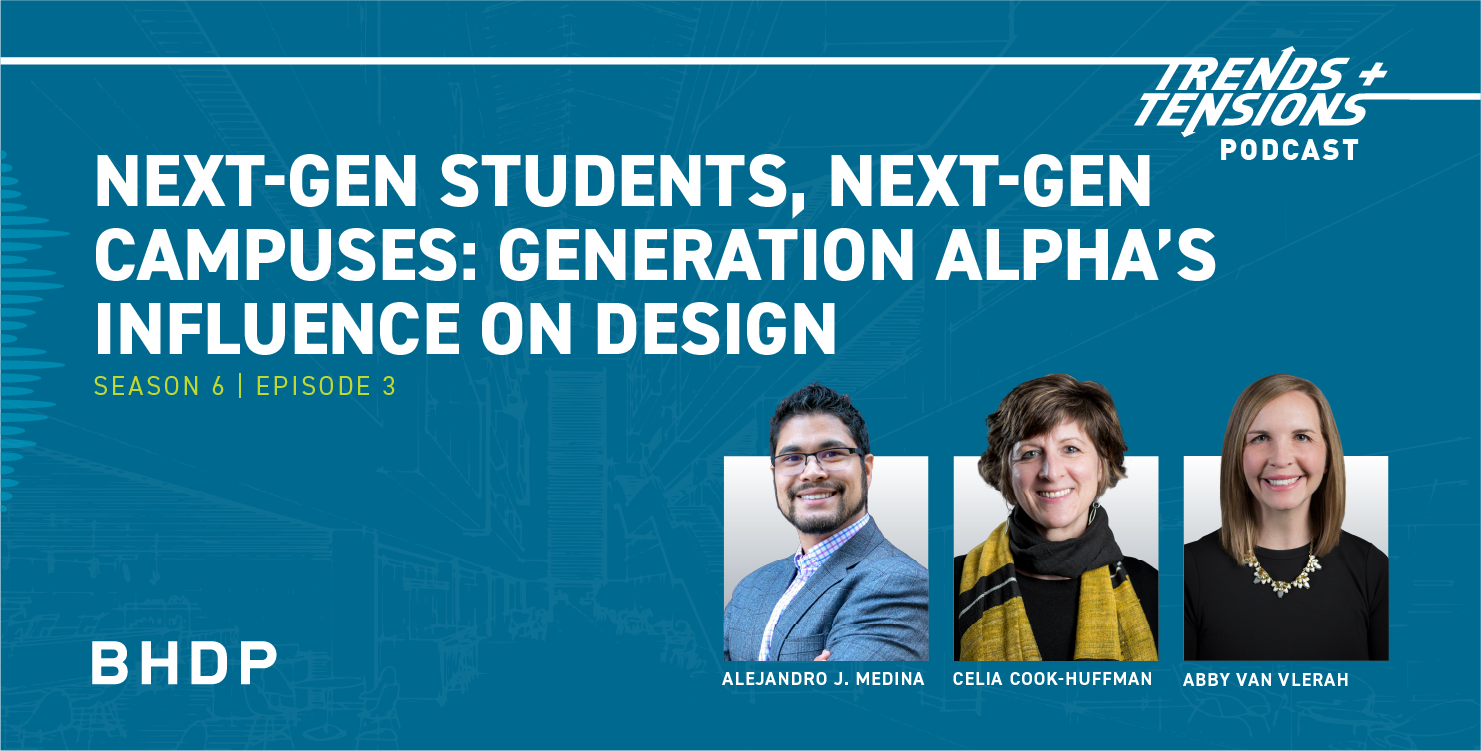
Want to listen on another platform? Choose your platform here.
Episode Transcript
[Music Intro]
Brian Trainer, Host: Welcome to Trends + Tensions, presented by BHDP, where we discuss Trends in Architectural and Interior design and the competing priorities or Tensions that arise from integrating new ideas into existing organizations, enterprises, and institutions. In this episode, "Next-Gen Students, Next-Gen Campuses: Generation Alpha's Influence," we are joined by Celia Cook-Huffman, Vice President for Academic Affairs at Manchester University, Abby Van Vlerah, Vice President for Student Life at Manchester University, and AJ Medina, Senior Architect at BHDP. I am your host, Brian Trainer, senior strategist for BHDP. Let's get started.
Brian: Celia, if you wouldn't mind telling us who you are and what you do.
Celia Cook-Huffman: So I'm Celia Cook-Huffman and I am the vice president for academic affairs at Manchester University.
Brian: Thank you, Celia. Abby, who are you and what do you do?
Abby Van Vlerah: Yeah. Hi. I'm Abby Van Vlerah and I am the vice president for student life at Manchester University.
Brian: Hello, Abby! And AJ?
Alejandro J. Medina: Hi, AJ Medina, senior architect with BHDP architecture.
Brian: Welcome everyone! Today, we're going to be talking about higher education, specifically generations within higher education and what they're looking for in that experience. My first question is who is late Gen Z and Gen Alpha, since that's what we're talking about today. Does anybody want to clarify that for me?
AJ: So I'll tell you the definition; the working definition that we are working with right now comes from Pew Research, and Gen Alpha is kind of defined as about 2013 as their birth date and beyond. Not really settled on an end date. And then late Gen. Z, when talking about them in the context of this conversation, is really those that are in school up through, you know, that 2013 demarcation date. Of course, generations kind of blur when they get between the lines. So it's not like we flip a switch in 2013, and all of a sudden, they're completely different people.
Brian: So 2013, if we're talking about Gen. Alpha, and I can do quick math in my head, they're 11 this year. So why is it important for us to be thinking about those generations when we're thinking about higher education?
Abby: Yeah, said with love, nothing in higher education moves fast. So, if we're thinking about making impacts on students who are 11 right now, that means we need to be forward-thinking in higher education. So, what do our classrooms look like? What do our spaces look like so that we can best serve those students? And I also think that with 'cuspers", I think you were just mentioning that, those people who are in between Gen Z and Gen Alpha, the late Gen Zers. Some of those students are already here and already taking college courses. There are so many opportunities for dual credit right now that we need to be thinking about those younger students as well. My nephew is 14, for example, and he's a first-year student in high school already taking dual degree classes with another institution.
Celia: I think it ranges, right? We're thinking about everything from, you know, what do they want. So in terms of degrees, educational opportunities, ways that education is delivered, right? What are they looking for? What do they want from us as education providers? How do they want to get it? They're really interested in dual degrees and early college experiences, but they're also interested in maybe online learning. Post-COVID, though, we're seeing a resurgence of wanting those face-to-face experiences. How do we communicate with them? Are they texters? Do they read emails? And again, as Abby is saying, and that's the current sort of students and those who are in the high school pipeline. For those 11-year-olds, what are they going to need and want from us as we think about how do we can provide an educational experience for them that meets those needs? Then, there are wraparound supports, which Abby can jump back onto. Again, what do they need in terms of both maybe academic preparedness support, emotional support, health, right?
Abby: Right, and in higher education, we even think about our spaces, right? I'm thinking if I'm building, from a student life standpoint, if I'm building a residence hall or a student union or even classroom space, that's going to happen in a slow time period. And so I need to be thinking now, and you all need to be designing the higher ed and college campus of the future, because it's what these students are going to want when they reach up.
AJ: Yeah, what's really interesting about moving forward in higher education is this is not just about academics. I mean, it's not being about that a long time ago, but what we're seeing the lay Gen Zs and predicting for the Gen Alphas is this holistic approach to their higher education experience. And what are all the different things that need to be tweaked and adjusted, not totally changed? But how do we make these incremental changes over the next several years so that we're ready for whatever that needs to look like when these Gen Alphas are fully on board in higher education?
Brian: Are there differences between late Gen Z and Gen Alpha? Is Gen Z informing for Gen Alpha? What are you learning from what these needs are? And how is that changing how you think about the educational experience?
Abby: I think some of it is that exactly what you said, that Gen Z isn't forming Gen Alpha. But I think if we look at the research, you know, AJ mentioned Pew Research before, it's kind of the big, big name in generational research. And a lot of what they're finding is that sometimes generations either double down in some areas, or they just totally revert back in others. And so areas in which generations tend to be doubling down are things like mental health, right? And so if Gen Zers were more concerned or reported more issues of mental health, more mental health concerns than generations prior to them, then Gen Alpha is going, we think, is going to do that even more. Again, I think we see that today, with the number of younger people who are involved in counseling, there is a number of guidance counselors and mental health support that is necessary in elementary schools right now, right? That trend is likely to continue. And so just trying to understand Gen Z, translating that in ways that we need to for Gen Alpha, I think, is super important.
AJ: And that's a great example because we can see that going back and forth a little bit between Alpha and Z. ArchitectureThat's a great example of a space that doesn't have to be so formal either. So, an example is Gen Alpha, which is growing up with what's called wellness or Zen spaces, right? That's very popular in K-12 where you can have a low distraction room. You can just kind of take a little bit of breather from your day and recenter yourself. Well, that's becoming a norm in higher education. It is a norm in K-12. Obviously, if you're going to an older school, maybe it's not quite there yet, but as these newer schools develop, it's very normal in K-12 to have that. And now, I can't think of a project in the last three years that I've designed that doesn't have some version of that included in it.
Brian: So, we had spoken prior to recording this, and I remember one of the things that you had brought up, there's a generational thing called Together Alone. What does that mean, and what does it mean to these generations that we're talking about?
Abby: Yeah, I experienced this firsthand the other day in the class that I teach. I walked in. They're normally relatively chatty, but I walked in on Wednesday, and every single one of them, sitting in seats next to each other, had their head buried in their phone. So, we are all doing something completely different, but in this shared space. And so, that idea translated to the residence hall or the cafe where they're hanging out, which is kind of what they're doing. They're seeking to spaces where they can be in the community, but really do something by themselves and not talk to anyone else. Every single one of them has a set of headphones in, right? And they may be talking to each other somehow, like in the text, right? They may be texting with each other in the room, but they're not actually talking to each other. Little bizarre for people who aren't used to that kind of thing.
AJ: Let me flip that on you. That is a great example of alone together, which is a Gen Z phenomenon, okay? That is being independent, but in a shared space. What we're predicting for Gen Alpha is the reverse of that, together alone. And what that is is that because of the effects of COVID, because they were not social for so long, they are going to crave more social experiences, but they're going to want to be in smaller spaces, right? But actually have a rebound effect, so they're not going to double down on the Gen Zs of just being on your texting. You're going to have a rebound effect for the Gen Alphas and want to actually talk to each other, want to actually be in groups, but very small groups, three, four people max. We're thinking, we're actually kind of hoping that that flips itself in about five, six years.
Brian: So what are you doing design-wise for higher education to prepare for that? How does that change how we think about space?
AJ: Sure. So one thing we do today is that a lot of us have been into learning commons, studying commons, et cetera. In fact, we just did something kind of similar in the office space, blended space at Manchester's Fort Wayne campus, big open space, but pockets of space where you can just sit in a comfy chair and text on your phone, and you'll be fine. You'll be around other people, but you can be by yourself. We're starting to revert back to kind of the model that we designed, not fully, revert back to the model that was designed 10, 20 years ago where a lot more groups study spaces, smaller pockets of space that are more enclosed, where a group can be a little bit louder, not disturb the group next to them, and do what they want to do. So does that mean we're doing all enclosed spaces, death of the open office? No, absolutely not. But it's kind of just where it used to be, maybe 10% of the space was dedicated to these enclosed spaces, now maybe we're going to up that to 25% or something like that.
Celia: I mean, is there anything in there, again, when we talk about Together Alone, the folks whose community is online, like my kid, he's alone on his computer, but he's with his community of fellow gamers, and that's a powerful support community for him.
Abby: I think too, AJ, to support a little bit of what you were saying, from Manchester's perspective, we're seeing pre-pandemic numbers of attendance for our student events. So we are back to students wanting to engage together, potentially in larger numbers, definitely in larger numbers than they were during the pandemic and in the two years or so, three years post-pandemic. But last year, those attendance rates were back up where they were before the pandemic. So people are wanting to come back together, at least from our perspective.
AJ: We get a lot that, oh, we're going to be so virtual, we're going to be so hybrid, et cetera, et cetera. Do you think there's something innate, and I'm going to go off the deep end here for a minute? Do you think there's something innate in our human nature, regardless of whether you're introverted, extroverted, et cetera, that you kind of crave that connection, that physical, real human connection? Because, you know, virtually watching a student event, a football game, just not the same experience.
Abby: Yeah, I think even with Gen Z, we see that they don't know how to interact socially because they've grown up as digital natives, but they want to. I mean, Gen Z, in particular, I think, says that they're, this again is Pew Research, says that their favorite mode of communication is in-person. And so they don't necessarily want a text message or an email or whatever. They want that in-person connection. They just don't know how to do it. And so part of the reason that student life jobs exist is because we're trying to tell people how to be fully formed adult human beings, where you like to interact with someone in a real space instead of just a virtual environment.
AJ: Wow, that's shocking to hear. It's encouraging, but that is shocking to hear. Their favorite mode of communication is still in-person.
Brian: Wow. Interesting. So I have one more question. What challenges, we alluded to faculty-specific challenges. What challenges are faculty facing when working with Late Z and Alpha? And I'd heard you speak about understanding the needs and values of students. Are there any other challenges to add to that?
Celia: I mean, you can pick and choose what you want. I mean, I think self-advocacy, right? How are they developing self-advocacy skills? Again, things I think that historically, we did not think that we needed to help them scale up or teach them, right? We're teaching them now in college instead of some of those things being things that they learned in high school. We're helping them learn how to communicate appropriately with one another. We're helping them learn how to be in teams, right? And act appropriately and according to sort of shared social norms and values about what it means to be a good team member.
Abby: I think, too, we're going to constantly be challenged as students move through the educational system in higher ed because depending on where they were during the pandemic, they all but missed those years of their education. Like K-12 teachers did the best they could with what they had, and helping some students, some young people, through those digital learning experiences when we were all just doing what we could to hang on really impacts what they learned, and so if you were in 3rd and 4th grade during the pandemic, you may be lost a really different set of information than someone who was in a junior, a senior in high school during the pandemic and so I think as K-12 continues to adapt to what they have to teach back, we're going to need to change the pieces that we end up teaching back. That trickle-down will be felt, I think, for a long time.
AJ: Yeah, it's interesting because you kind of hint on what I'm wondering is, and only time will tell, are some of these communication gaps that you were talking about, Celia, are they going to resolve themselves in five to six years, or will they be worse because in five to six years, those communication gaps will actually be a fundamental core memory idea because of how young they were when those happened, or will they bounce back, recognize that, no, that didn't work. They spend their middle school years and high school years kind of overcoming that, rebounding from it, and they come into higher education with fantastic interpersonal communication skills, and we won't know, right? We all can hope which one we want, but we won't know exactly what's going to happen till a few years from now.
Celia: Then again, that self-advocacy piece, I think, just continues to be one of those similar kinds of things. Are we going back to more free play and less structured lives for young people, or not?
AJ: Well, you hit on a huge topic that we don't have a lot of time to cover, but, right? Gen Z is raised by Gen X, who coined the term helicopter parenting, and we'll have to do another podcast on what that means. But what we're going to see is with Gen Alpha, raised by millennials, who reverted back to what is coined as free-range parenting, right? So now, what's Gen Alpha going to be like when we kind of flip the script? So again, interesting things to see what happens in time.
Celia: I mean, I'll just throw this one out too for another time in the podcast, right? I think the other issue that they're bringing with them is, what do safety and security look like, right? Again, this is a huge issue for young people who are coming through school shootings and violence in their schools, and not all of our students, but some of them come from spaces where they go through metal detectors. So again, that question about how do we create a sense of safety and security on our college campuses for these young people, also a huge, huge difference.
Brian: That could be its own podcast
Abby: Yeah, bring us back for that one because, yeah, we have a lot to say.
Celia: Season two.
Brian: Exactly. Well, thank you so much for joining us today. Abby, Celia, AJ, I hope you had a nice time. I love hearing about your expertise.
Abby: Yeah, thank you so much for having us.
Celia: Yeah, pleasure to be with you.
Brian: Awesome. Well, thank you all again, and I hope to talk to you again soon.
[Music Outro]
Brian: Thank you for joining Trends + Tensions presented by BHDP for this episode, "Next-Gen Students, Next-Gen Campuses: Generation Alpha's Influence," with Celia Cook-Huffman and Abby Van Vlerah of Manchester University and AJ Medina of BHDP. If you appreciate what you have heard, please rate, subscribe, and give us a review.
I am Brian Trainer, your host, and I hope you'll join us for another episode of Trends + Tensions to see what topics drive design.
Author
Content Type
Podcast
Date
December 23, 2024
Market
Practice
Topic
Design Thinking
Technology

